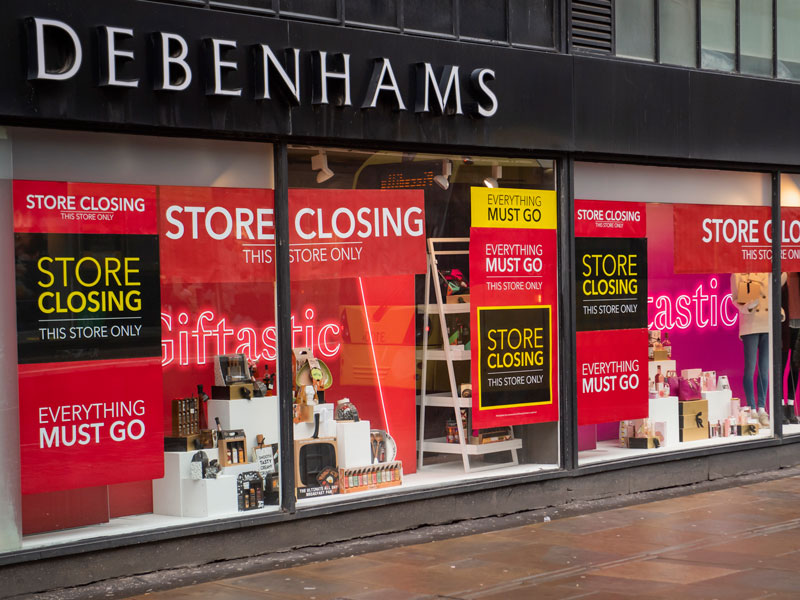

Debenhams, Jaeger, Laura Ashley and TopShop are just a few of the high street names having gone – or being on the brink of going – into administration in the UK following a trading year obliterated by COVID-19. The who’s who of doomed retailers makes for stark reading. And similar stories can be found in many economies around the world. There is no denying that while the pandemic has hit many sectors hard, high street retailers have suffered significantly with the prospect of survival, let alone growth looking bleak.
For all businesses weathering the storm of the pandemic, minimising costs and realising value is more important than ever. If ever there was a time for lateral thinking and alternative solutions, it is now. To put the wider landscape firmly in the picture, the latest Business Impact of Coronavirus Survey (BICS) conducted by the ONS found that 64 percent of the UK’s six million businesses are currently at risk of insolvency, with 43 percent of companies running on fewer than six months of cash reserves. It will come as no surprise that industries such as retail and hospitality are at particular risk.
The survey also revealed that 14 percent of all UK businesses have already halted trading as a result of local lockdown restrictions. It is in this vein that the Business Secretary, Alok Sharma, has, under the Corporate Insolvency and Governance Act 2020, further extended the easing of insolvency rules until March 2021. This legislation governs whether company directors can keep trading if there is no reasonable prospect that the company can avoid insolvency. If there is no such prospect, the Insolvency Act 1986 requires them to cease trading. These rules were originally relaxed in March 2020 to help troubled firms deal with the financial shock of the pandemic and plot a course through the crisis.
The commodity of time
Businesses can take advantage of the breathing space this relaxation affords to try to avoid insolvency, which inevitably leads to redundancies and knock-on effects for suppliers and business partners. Thinking of new solutions and exploring alternative steps can buy precious time. One such alternative that has proven successful is to look at unrealised assets within the company that are not typical to their ordinary course of business. This can include a range of options, including one many firms will not have thought of – the pursuit of legal claims against third parties.
The prospect for businesses having to litigate is often unattractive and is usually a distraction from their core operations. Litigation consumes internal resources – management time as well as cash. Disputes can take years to resolve and even then, there are no guarantees of success. But the reality is that any commercial dealing comes with the risk of disputes and when they do arise, they need to be dealt with. Businesses struggling in the current economic climate may still have good claims – some may even be directly related to the pandemic – with commercial partners being found to have wronged a company. It could be an unpaid debt, a breach of contract, a breach of a statutory duty or a claim for negligence against advisors. There may also be historical claims that the company has not previously had the time or resources to pursue.

The key is a mindset shift towards viewing litigation as an asset rather than a drain on resources (some disputes can be worth tens if not hundreds of millions). Identifying, bringing and prevailing on these disputes can change the game completely, and the growing sophistication of the litigation funding market has provided support to companies when it comes to ensuring that value is realised from claims. Before the pandemic, the UK insolvency litigation market had grown by 50 percent over the previous four years to be worth approximately £1.5bn per year, largely assisted by an uptake in third-party funding. One study has estimated that the total value of claims funded through litigation funding is worth around £720m per year, accounting for roughly half of all insolvency claims.
Funders can provide funding for all of the legal costs incurred in bringing a claim on a non-recourse basis, as well as covering the adverse costs risk, should the claim not succeed. Funding can also be provided to meet liquidators’ fees, disbursements and other costs. A successful claim not only helps improve the financial position for the business but for its creditors and investors too. In the current and ongoing climate, that is an important factor to weigh up. HMRC is often on the creditors list, so the wider public interest is a factor as well. But litigation funding in insolvency cases is not the answer to all problems. Not every claim will be suitable for funding and it is incumbent upon professional funders not to support meritless claims – the truth is, experienced funders will not entertain them, which makes their decision-making process a good yardstick for what can be pursued.
While governments have sought to insulate businesses from the risk of insolvency in 2020 and 2021, there is no magic wand. The stark reality remains that many businesses, particularly those in more vulnerable sectors such as retail and hospitality, will take time to recover and until then, will remain in a precarious position. An important part of each business’ steps to improve its solvency should include consideration of the genuine claims it may have against third parties – and how securing funding for those claims may be in its best interests.


